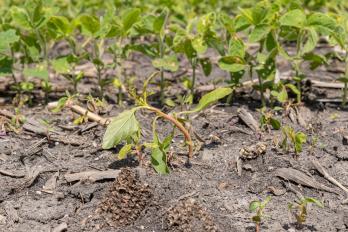“WEED RESISTANCE” WILL PERSIST AS THE BUZZ WORD IN 2021
Jan 11, 2021

Federated Agronomist John Swanson shared an eye-opening story with valuable perspectives on weed resistance:
“Every winter I go to educational meetings put on by the University of Minnesota and the University of Wisconsin. A hot topic for a while now has been “weed resistance.” I have listened to experts from Arkansas, Illinois, and Missouri as they discussed weeds with resistance to up to five or six different modes of action. They recommended we try to avoid the situation they are in!
“Here at Federated, we have seen glyphosate resistance in giant ragweed and waterhemp but, to this point, nothing more. Federated has recommended the use of pre-emerge herbicides and layering residuals in our post applications.
“In 2020 I got a real eye opener. There were fields on which we were unable to get a “pre” herbicide applied that we treated post-emerge with Flexstar GT (which is a site of action group 14 or PPO inhibitor). The waterhemp in those fields did not die.
“With help from our chemical supplier, we sent samples from five fields to the University of Illinois for genetic testing. All five samples came back with resistance to PPO and glyphosate. There could have been more resistance found in the samples, too, if we had done further testing. This was my first experience with resistance to multiple modes of action.
“The scary part in these 2020 test results is that I felt we had good weed control in these fields the previous year, in 2019. It can blow up on us that fast. If we continue to repeatedly use the same modes of action, we will soon lose those modes of action as viable options for weed control.
“What can we learn from this and how can we improve for the future?
“We need to rotate sites of action, not just herbicides. One of the more important lessons I have learned from our southern friends is to apply herbicides with multiple sites of action. The more modes we apply, the better chance we have to kill that weed and not allow a resistant population to survive and explode. (This chart explains herbicide classifications and sites of action.)
“We can try to rotate crops, too, using corn where we have better herbicide choices than we have with soybeans. We can also rotate into small grains or perennials such as alfalfa; these crops have different life cycles that can affect weed control.
“Also, if possible, use mechanical weed control measures like primary tillage or in crop cultivation. And be sure to use an extensive scouting program to identify weed species and pressure. Scouting allows us to identify resistance as soon as possible.
“I know I will sound like a broken record, but we also need to continue to use our pre-emerge programs. It is hard for weeds that never emerge to become resistant to herbicides.
“Growers in the southern parts of the corn belt are finding success by layering their residual products. The hard-to-control weed species can germinate for long periods of time – which is what makes them so hard to control. There is currently no resistance to Group 15 herbicides. Adding a residual product with post applications can help prevent these weeds from germinating later in the season when it isn’t possible to respray.
“We need to look at moving away from soybeans with exclusively Roundup Ready® traits and consider new products that give us multiple herbicide tolerances, such as Enlist E3™ and XtendFlex® soybeans. But, we also must remember that these products are just tools to use as a total management program. They cannot be used alone, or we will soon lose these new technologies to resistance as well.
“The reality is that weed control continues to get more difficult every year. We are seeing more resistance all the time. We need to learn from others and try to prevent resistance if we can.
“Talk to your local Federated Agronomist to determine what herbicides with multiple modes of action will fit your farm.” (Explore herbicide-resistance management options with this app, too.)